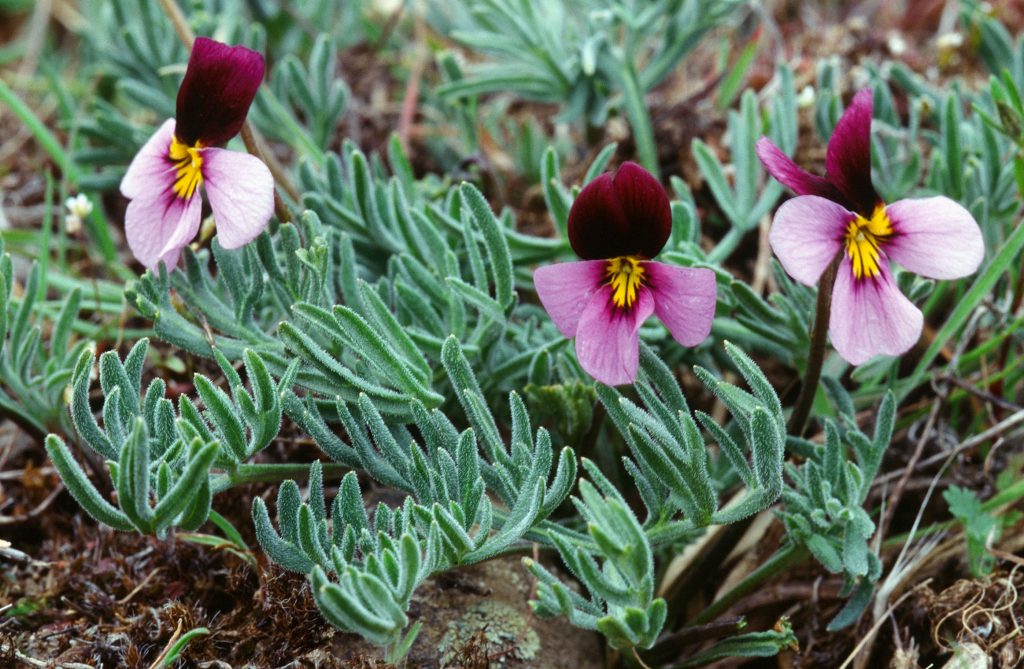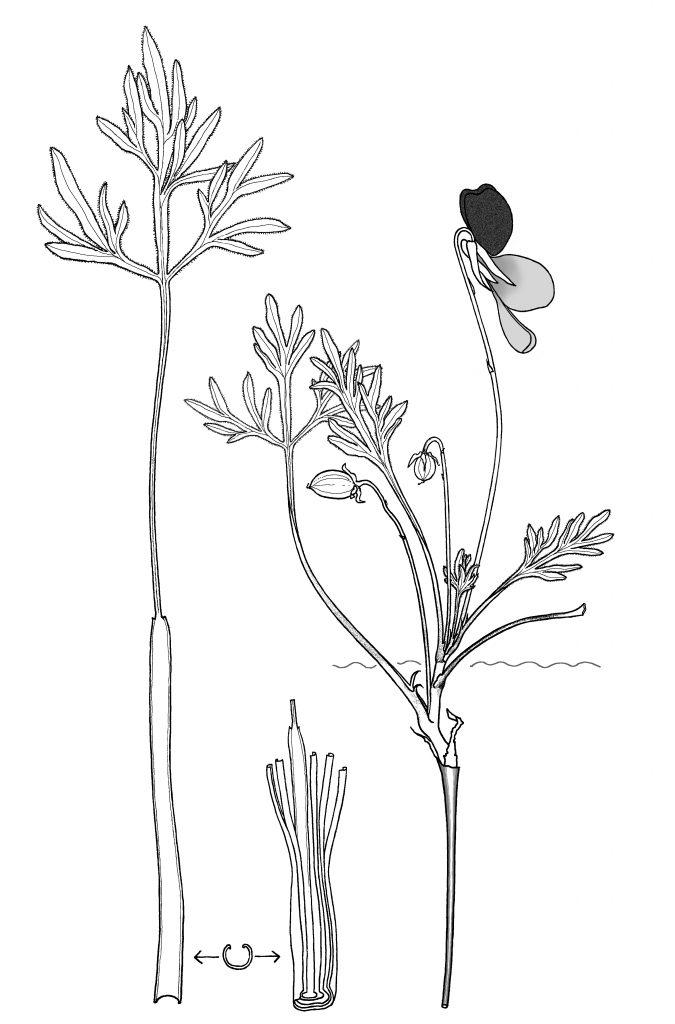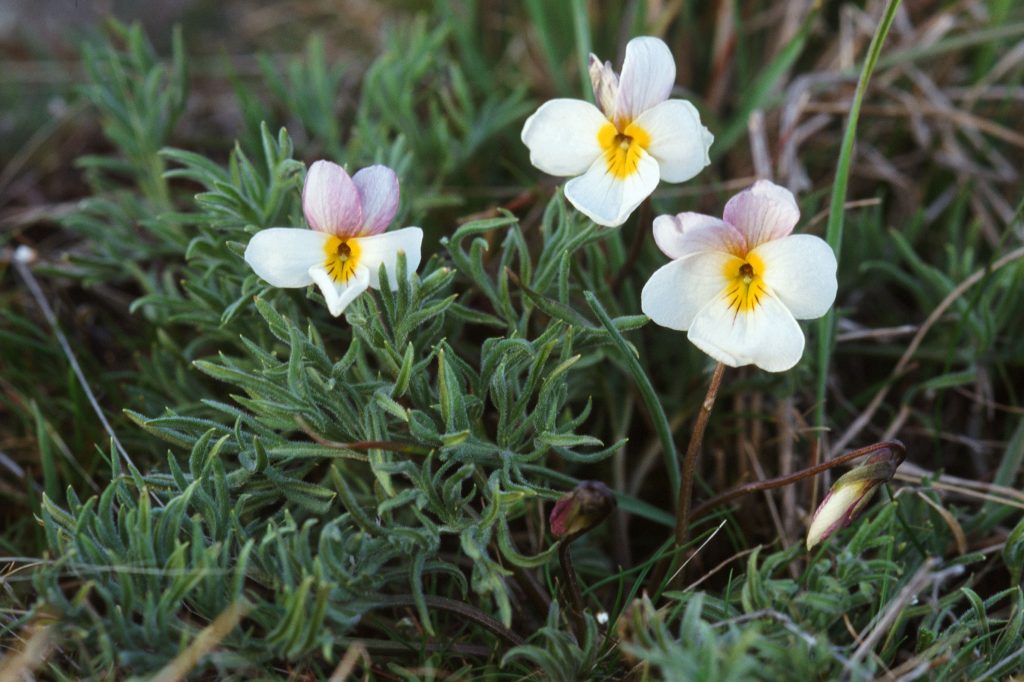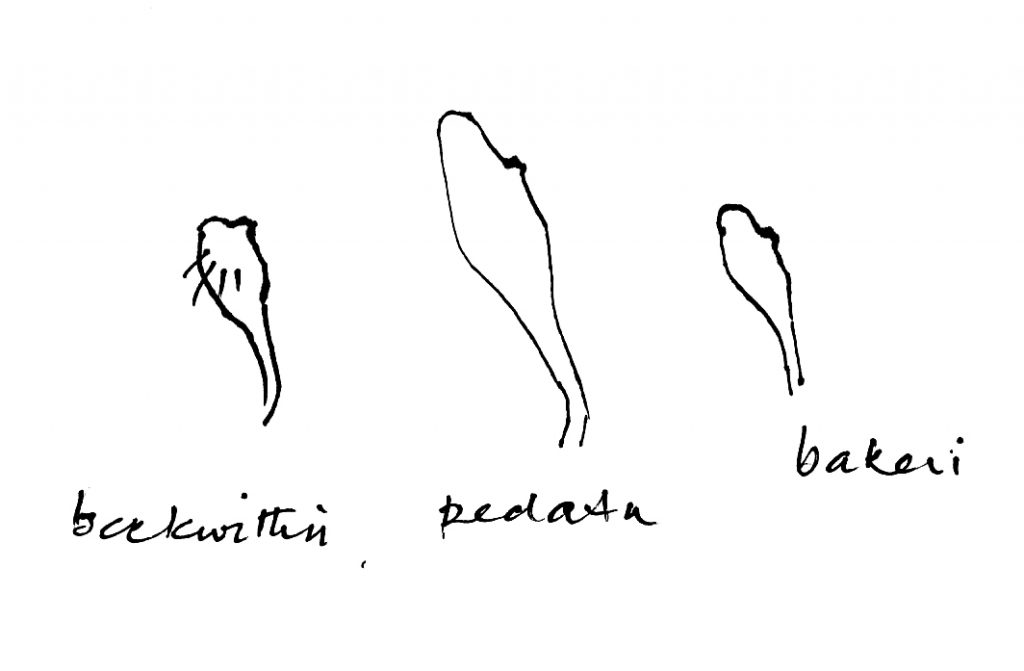Viola beckwithii
Description. Illustrations: 4 photographs of Viola beckwithii and 3 drawings.
Viola beckwithii is a lovely violet with large, open two-toned flowers and attractive deeply divided foliage. These plants are highly adapted to the extremes of weather in their habitat and are very difficult to cultivate. In common with many other desert plants, their leaves are gray in color, often appearing more silver because of their dense covering of very short hairs. Water evaporation from the plants is reduced by the dense pubescence and by the reduced leaf surface area. There is a glabrous form with wider leaf segment has been recognised as Viola beckwithii subsp. glabrata.

Flowering in early spring, the plants produce and disperse their seeds within a month, yellowing as they die down early to avoid the hot dry summer. Only cotyledons are produced in the year of germination, the second year a pair of true basal leaves emerges, and in subsequent years leafy stems are produced. As the crown of the plant is buried 6-8 cm underground, the several stems appear to be short. They are produced from a short, stout rhizome with pale, strong, fibrous roots that spread very widely.

Both basal and cauline leaves, gray to silver color common to many desert plants, may be densely but minutely pubescent, or glabrous; the type specimen being described as ‘hirsute’. The short cilia are on the top leaf surface and margins only. The leaves are deeply divided, initially into three, each segment divided again twice or three times resulting in fine, linear to lanceolate or spathulate-linear lobes. These divisions are slightly fleshy and often recurved. The primary divisions of each leaf segment is more or less petiolate, longer on the central division. The obtuse tip of each segment ends in a prominent a white gland. The general leaf outline is deltate to ovate and up to 50 mm long, the petioles up to 80 mm long; the margin of the leaf is extended to form a winged petiole. Stipules are long and adnate to the petiole, on the basal leaves for more than half the length of the petiole. These winged petioles plus stipules wrap protectively around the central stem(s), petioles and peduncles to form a tough fibrous persistent sheaf most of which is buried underground, and through which the new season growth appears.
Where exposed, the above-ground petiole and peduncle may be purple. I have made two observations: Firstly, the leaves contain a sticky substance, possibly pectin, that may help retain moisture. When reconstituting a dried summer specimen in water, the leaves became gelatinous then glued very firmly to the paper in which it had been pressed. Secondly, the dried roots, stems and sheath are so tough that they could not be broken.

Flowers March to late June depending on altitude and the season, early or late, wet or dry. Strongly perfumed flowers are large (2.8-3.5 cm) standing well above the leaves. Peduncle very dark green-purple, pubescent, very short, usually pointing downwards.
There is a bright yellow central throat on the base of all petals; the two upper petals are dark velvety red-purple to almost black, often folded back to back; the three lower petals are lighter mauve-lilac color to pure white, with dark, red-violet guidelines mainly on the lowest or spurred petal. The lateral petals are bearded with yellow clavate hairs, the spur petal longer than the laterals and indented at the base. Occasionally all petals are nearly white white but still with yellow center. The dark purple spur is very short, 0.1 cm long x 0.3 cm wide. Ovary glabrous, the style head with lateral projections. Sepals are dark green-purple, long, narrow, gradually tapering to tip, 0.9 cm; the auricles are extremely short.
The capsule is green, round to elliptical, glabrous, 7–12 mm long, favoured by small rodents. There are no closed (cleistogamous) flowers or pods. The seeds are large, 3.5-5.0 mm long x 2.0 mm wide, pale honey brown.

Viola beckwithii grows on rocky flats or bare slopes, in full sun, often among sagebrush, in open grassy fields or between scattered shrubs of juniper and yellow pine. The soil is deep, fine, porous silt composed of volcanic materials from ancient basalt laval flood plains and lake bottoms. Locations are vernally moist, the precipitation mainly from snow melt, but become very dry in summer when the soil sets like cement.
This violet species is locally common in the Great Basin area of eastern Oregon, southern Idaho, western Nevada, northwest and north central Utah and California on the east side of the high Sierra Nevada range south to Inyo Co. It is a plant of higher altitudes, 900 to 2700 m.

Nomenclature and Taxonomy:
Section Chamaemelanium Ging., subsection Chrysanthae (Clausen, 1964).
Viola beckwithii Torr. & Gray subsp. beckwithii. Pac. R. R. Rept. 2: 119. t. 1, 1855.
A tetraploid species, 2n=4x=24 where x=6, the base chromosome number of this section.
V. beckwithii was first collected by Snyder in 1854, in Eureka County, Nevada and first described in his report for the Pacific Rail Road: Beckwith Survey, 41st Parallel. It was named in honor of Lieutenant E. G. Beckwith, U.S. Army, who in 1854 conducted a topological survey from Great Salt Lake, Utah, to the Sacramento Valley in California.
Viola beckwithii subsp. glabrata Baker, M.S., Madrono 12:18. 1953, collected 24 May 1952 in Plumas Co., California. Yellow Pine forests, Sierra County to Lassen Cos, California.
Viola utahensis M.S. Baker & J.C. Clausen X beckwithii Torr. & A. Gray. 2002.
(syn. Viola beckwithii Torr. & A. Gray X utahensis M.S. Baker & J.C. Clausen).
Utah, Cache Co., Elevation: 1463 m. collected by Gerrit Davidse, 26 April 1967. At least ten plants were growing in a small area, which might indicate some seed production. 2N=24. Meiosis is very irregular. The two top petals are mid-purple, but the colour is uneven in density, some paler, with a few patches of the dark velvet purple-black usual for V. beckwithii. The lateral petals are streaked with the same mid-purple color of the top petals, on a white background; the lowest petal has a typical basal yellow patch with black-purple guidelines, surrounded mainly by white but with purple splashes. The leaves are irregularly lobed, part way between those of each parent.